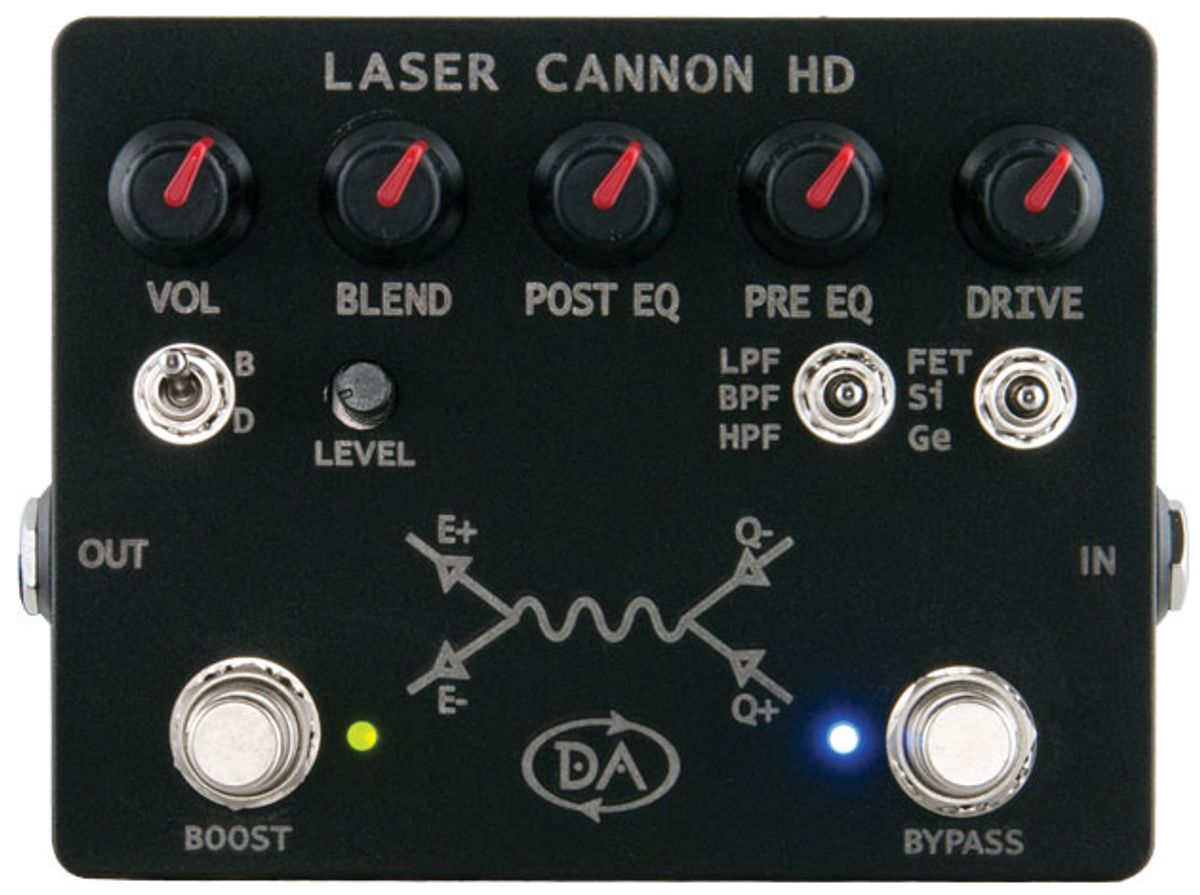
A solid fuzz/distortion for bass with a wide variety of tones.
San Francisco’s Daring Audio has approached pedal design from the bassist’s perspective since 2010. They understand the issues low-enders face when crafting tones onstage and in the studio, and the frustration of dealing with gear that can’t handle a bass’s frequency range. The company recently updated the Laser Cannon, one of their inaugural offerings. The revamped Laser Cannon HD adds an assignable boost function, state-variable filters, and an FET clipping mode.
Laser Focus
The Laser Cannon HD’s blend knob adjusts the balance between the wet (distorted) and dry signals. Meanwhile, the drive control provides everything from mild overdrive to raging fuzz via a tweaked version of the original Laser Cannon distortion circuit.
Among the pedal’s coolest features is its three-position state-variable filter switch, which works in tandem with the pre-EQ control to set the hi-pass, low-pass, or band-pass frequency. A post-EQ knob sets the amount of upper harmonics in the overdriven signal for smoother or harsher tones. A three-way diode selector offers germanium, silicon, and FET distortion colors. Another cool feature is a dual-purpose boost switch, which can be set to increase either volume or distortion.
Loose Cannon
The Laser Cannon HD’s control layout can seem intimidating at first. Some functions are perfectly obvious (volume, drive, blend) though clearer labeling of others might ease the pedal’s learning curve.
Ratings
Pros:
Solid and attractive build. Useful filters. Huge tonal range.
Cons:
Relatively steep learning curve.
Tones:
Ease of Use:
Build/Design:
Value:
Street:
$199
Daring Audio Laser Cannon HD
daringaudio.com
I placed the Laser Cannon HD between a Fender American Jazz Bass and a Verellen Meatsmoke head pushing an Ampeg 8x10. I dialed in smooth germanium-diode fuzz with the pedal’s blend knob halfway up and the pre-EQ toggle set to low-pass. It seemed that moving the blend knob away either direction from its noon position boosted the actual volume of signal, as opposed to altering only the blend ratio, and would drop a bit when I moved back to the noon position. With that said, it’s certainly possible I simply perceived decibel changes due to waveform changes. Still, to get the exact 50/50 mix I desired at unity, I felt I had to compensate a bit via the pedal’s volume boost. This isn’t a huge deal when dialing in a set-and-forget tone, but might be in issue when tweaking mid-song.
Daring says that their customers demanded a perfectly dry signal in the full counterclockwise blend-knob setting. Accordingly, there is no way for perceived volume levels to remain even when moving the blend control. And for high-drive settings, the blend from wet to dry will get louder, because of gain added by the distortion circuit.
The pre- and post-EQ controls are indispensible for fine-tuning highs and lows. I tended to use them conservatively—but if extreme is your thing, the Laser Cannon can dispense it in spades. Seething grind? Mammoth subs? Nasal highs? No problem.
Switching to the decidedly louder silicon-diode setting and adding more distortion took my tone from smooth and detailed to rigid and fierce. With the boost switch set add even more distortion, I achieved vicious industrial fuzz reminiscent of Paul Barker, Paul Raven, and Thrones-era Joe Preston.
The Laser Cannon HD’s tones take on a more tube-like (yet less compressed) character in FET mode. Setting the drive knob at 2 o’clock in band-pass mode provided a convincing boosted SVT tone, evoking the amp’s responsive dynamics and signature purr. The FET mode was my clear favorite for overdriven rock tones.
The Verdict
The Laser Cannon HD supplies an excellent range of overdrive, distortion, and fuzz tones, though you may need to invest time in learning how its controls operate and interact. Once you do, you’ll discover tons of exciting ways to shape distorted tones.
